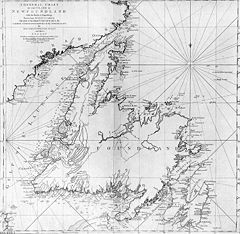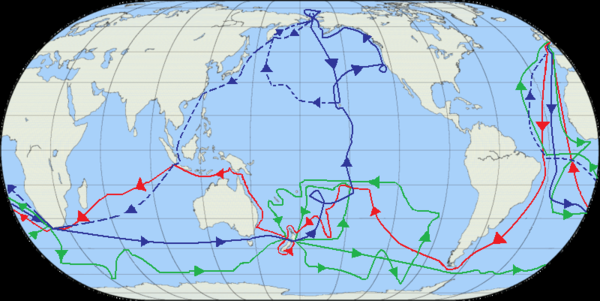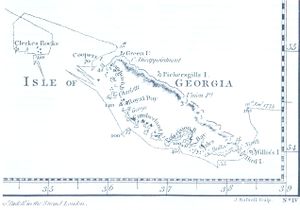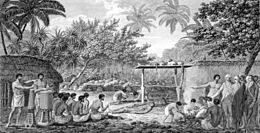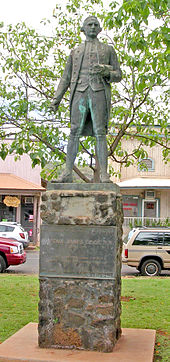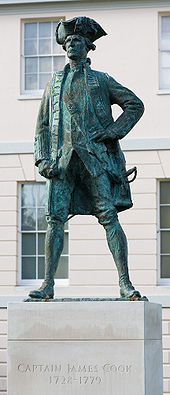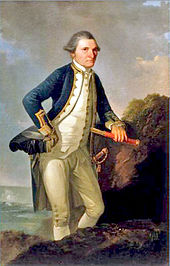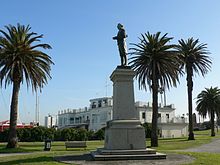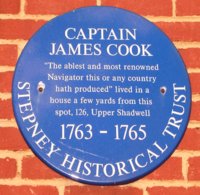- James Cook
-
"Captain Cook" redirects here. For other uses, see Captain Cook (disambiguation).
James Cook 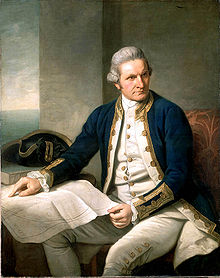
James Cook, portrait by Nathaniel Dance, c. 1775, National Maritime Museum, GreenwichBorn 7 November [O.S. 27 October] 1728
Marton, (in present-day Middlesbrough) Yorkshire, EnglandDied 14 February 1779 (aged 50)
HawaiiNationality British Education Postgate School, Great Ayton Occupation Explorer, navigator, cartographer Title Captain Spouse Elizabeth Batts Children James Cook, Nathaniel Cook, Elizabeth Cook, Joseph Cook, George Cook, Hugh Cook Parents James Cook, Grace Pace Signature 
Captain James Cook, FRS, RN (7 November 1728[NB 1] – 14 February 1779) was a British explorer, navigator and cartographer who ultimately rose to the rank of captain in the Royal Navy. Cook made detailed maps of Newfoundland prior to making three voyages to the Pacific Ocean, during which he achieved the first European contact with the eastern coastline of Australia and the Hawaiian Islands, as well as the first recorded circumnavigation of New Zealand.
Cook joined the British merchant navy as a teenager and joined the Royal Navy in 1755. He saw action in the Seven Years' War, and subsequently surveyed and mapped much of the entrance to the Saint Lawrence River during the siege of Quebec. This helped bring Cook to the attention of the Admiralty and Royal Society. This notice came at a crucial moment in both Cook's career and the direction of British overseas exploration, and led to his commission in 1766 as commander of HM Bark Endeavour for the first of three Pacific voyages.
In three voyages Cook sailed thousands of miles across largely uncharted areas of the globe. He mapped lands from New Zealand to Hawaii in the Pacific Ocean in greater detail and on a scale not previously achieved. As he progressed on his voyages of discovery he surveyed and named features, and recorded islands and coastlines on European maps for the first time. He displayed a combination of seamanship, superior surveying and cartographic skills, physical courage and an ability to lead men in adverse conditions.
Cook was killed in Hawaii in a fight with Hawaiians during his third exploratory voyage in the Pacific in 1779. He left a legacy of scientific and geographical knowledge which was to influence his successors well into the 20th century and numerous memorials worldwide have been dedicated to him. However, his role in opening areas of the Pacific to colonisation and its subsequent effects on indigenous peoples have been the subject of both political and scholarly debate.
Contents
Early life and family
Cook was born in the village of Marton in Yorkshire, now a suburb of Middlesbrough.[1] He was baptised in the local church of St. Cuthbert, where his name can be seen in the church register. Cook was the second of eight children of James Cook, a Scottish farm labourer from Ednam near Kelso, and his locally born wife, Grace Pace, from Thornaby-on-Tees.[1][2][3] In 1736, his family moved to Airey Holme farm at Great Ayton, where his father's employer, Thomas Skottowe, paid for him to attend the local school. In 1741, after five years schooling, he began work for his father, who had by now been promoted to farm manager. For leisure, he would climb a nearby hill, Roseberry Topping, enjoying the opportunity for solitude.[4] Cooks' Cottage, his parents' last home, which he is likely to have visited, is now in Melbourne, having been moved from England and reassembled, brick by brick, in 1934.[5]
In 1745, when he was 16, Cook moved 20 miles (32 km) to the fishing village of Staithes, to be apprenticed as a shop boy to grocer and haberdasher William Sanderson.[1] Historians have speculated that this is where Cook first felt the lure of the sea while gazing out of the shop window.[3]
After 18 months, not proving suitable for shop work, Cook travelled to the nearby port town of Whitby to be introduced to friends of Sanderson's, John and Henry Walker.[5] The Walkers were prominent local ship-owners and Quakers, and were in the coal trade. Their house is now the Captain Cook Memorial Museum. Cook was taken on as a merchant navy apprentice in their small fleet of vessels, plying coal along the English coast. His first assignment was aboard the collier Freelove, and he spent several years on this and various other coasters, sailing between the Tyne and London. As part of his apprenticeship, Cook applied himself to the study of algebra, geometry, trigonometry, navigation and astronomy—all skills he would need one day to command his own ship.[3]
His three-year apprenticeship completed, Cook began working on trading ships in the Baltic Sea. After passing his examinations in 1752, he soon progressed through the merchant navy ranks, starting with his promotion in that year to mate aboard the collier brig Friendship.[6] In 1755, within a month of being offered command of this vessel, he volunteered for service in the Royal Navy, when Britain was re-arming for what was to become the Seven Years' War. Despite the need to start back at the bottom of the naval hierarchy, Cook realised his career would advance more quickly in military service and entered the Navy at Wapping on 7 June 1755.[7]
Cook married Elizabeth Batts (1742–1835), the daughter of Samuel Batts, keeper of the Bell Inn, Wapping[8] and one of his mentors, on 21 December 1762 at St. Margaret's Church in Barking, Essex. The couple had six children: James (1763–94), Nathaniel (1764–81), Elizabeth (1767–71), Joseph (1768–68), George (1772–72) and Hugh (1776–93). When not at sea, Cook lived in the East End of London. He attended St Paul's Church, Shadwell, where his son James was baptised. Cook has no direct descendants—all his children either pre-deceased him or died without having children of their own.[9]
Further information: Great Britain in the Seven Years' WarCook's first posting was with HMS Eagle, sailing with the rank of master's mate. In October and November 1755 he took part in Eagle's capture of one French warship and the sinking of another, following which he was promoted to boatswain in addition to his other duties.[7] His first temporary command was in March 1756 when he was briefly the master of the Cruizer, a small cutter attached to the Eagle while on patrol.[7][10]
In June 1757 Cook passed his master's examinations at Trinity House, Deptford, which qualified him to navigate and handle a ship of the King's fleet.[11] He then joined the frigate Seven Years' War, he served in North America as master of Pembroke.[13] In 1758, he took part in the major amphibious assault that captured the Fortress of Louisbourg from the French, after which he participated in the siege of Quebec City and then the Battle of the Plains of Abraham in 1759. He showed a talent for surveying and cartography, and was responsible for mapping much of the entrance to the Saint Lawrence River during the siege, thus allowing General Wolfe to make his famous stealth attack on the Plains of Abraham.[6]
Cook's aptitude for surveying was put to good use mapping the jagged coast of Newfoundland in the 1760s. He surveyed the northwest stretch in 1763 and 1764, the south coast between the Burin Peninsula and Cape Ray in 1765 and 1766, and the west coast in 1767. His five seasons in Newfoundland produced the first large-scale and accurate maps of the island's coasts; they also gave Cook his mastery of practical surveying, achieved under often adverse conditions, and brought him to the attention of the Admiralty and Royal Society at a crucial moment both in his career and in the direction of British overseas discovery. Cook's map would be used into the 20th century—copies of it being referenced by those sailing Newfoundland's waters for 200 years.[14]
Following on from his exertions in Newfoundland, it was at this time that Cook wrote that he intended to go not only:
"... farther than any man has been before me, but as far as I think it is possible for a man to go."[11]
Voyages of Exploration
First voyage (1768–71)
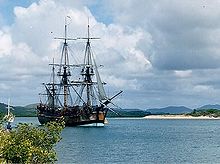 Endeavour replica in Cooktown, Queensland harbour — anchored where the original Endeavour was beached for 7 weeks in 1770.
Endeavour replica in Cooktown, Queensland harbour — anchored where the original Endeavour was beached for 7 weeks in 1770.
In 1766, the Royal Society engaged Cook to travel to the Pacific Ocean to observe and record the transit of Venus across the Sun. Cook, at the age of 39, was promoted to lieutenant and named as commander of the expedition.[15][16] The expedition sailed from England in 1768, rounded Cape Horn and continued westward across the Pacific to arrive at Tahiti on 13 April 1769, where the observations of the Venus Transit was made. However, the result of the observations was not as conclusive or accurate as had been hoped. Once the observations were completed, Cook opened the sealed orders which were additional instructions from the Admiralty for the second part of his voyage: to search the south Pacific for signs of the postulated rich southern continent of Terra Australis.[17] Cook later mapped the complete New Zealand coastline, making only some minor errors. He then sailed west, reaching the south-eastern coast of the Australian continent on 19 April 1770, and in doing so his expedition became the first recorded Europeans to have encountered its eastern coastline.[NB 2]
On 23 April he made his first recorded direct observation of indigenous Australians at Brush Island near Bawley Point, noting in his journal: "...and were so near the Shore as to distinguish several people upon the Sea beach they appear'd to be of a very dark or black Colour but whether this was the real colour of their skins or the C[l]othes they might have on I know not."[18] On 29 April Cook and crew made their first landfall on the mainland of the continent at a place now known as the Kurnell Peninsula, which he named Botany Bay after the unique specimens retrieved by the botanists Joseph Banks and Daniel Solander. It is here that James Cook made first contact with an Aboriginal tribe known as the Gweagal.[19]
After his departure from Botany Bay he continued northwards, and a mishap occurred, on 11 June, when Endeavour ran aground on a shoal of the Great Barrier Reef, and then "nursed into a river mouth on 18 June 1770.".[20] The ship was badly damaged and his voyage was delayed almost seven weeks while repairs were carried out on the beach (near the docks of modern Cooktown, at the mouth of the Endeavour River).[3] Once repairs were complete the voyage continued, sailing through Torres Strait and on 22 August he landed on Possession Island, where he claimed the entire coastline he had just explored as British territory. He returned to England via Batavia (modern Jakarta, Indonesia), where many in his crew succumbed to malaria, the Cape of Good Hope and the island of Saint Helena, arriving on 12 July 1771.
Interlude
Cook's journals were published upon his return, and he became something of a hero among the scientific community. Among the general public, however, the aristocratic botanist Joseph Banks was a bigger hero.[3] Banks even attempted to take command of Cook's second voyage, but removed himself from the voyage before it began, and Johann Reinhold Forster and his son Georg Forster were taken on as scientists for the voyage. Cook's son George was born five days before he left for his second voyage.[21]
Second voyage (1772–75)
Main article: Second voyage of James CookShortly after his return from the first voyage, Cook was promoted in August 1771, to the rank of commander.[22][23] Then, in 1772, he was commissioned by the Royal Society to search for the hypothetical Terra Australis. On his first voyage, Cook had demonstrated by circumnavigating New Zealand that it was not attached to a larger landmass to the south. Although he charted almost the entire eastern coastline of Australia, showing it to be continental in size, the Terra Australis was believed to lie further south. Despite this evidence to the contrary, Alexander Dalrymple and others of the Royal Society still believed that this massive southern continent should exist.[24]
Cook commanded HMS Resolution on this voyage, while Tobias Furneaux commanded its companion ship, HMS Adventure. Cook's expedition circumnavigated the globe at a very high southern latitude, becoming one of the first to cross the Antarctic Circle on 17 January 1773. He also surveyed, mapped and took possession for Britain of South Georgia explored by Anthony de la Roché in 1675, discovered and named Clerke Rocks and the South Sandwich Islands ("Sandwich Land"). In the Antarctic fog, Resolution and Adventure became separated. Furneaux made his way to New Zealand, where he lost some of his men during an encounter with Māori, and eventually sailed back to Britain, while Cook continued to explore the Antarctic, reaching 71°10'S on 31 January 1774.[11]
Cook almost encountered the mainland of Antarctica, but turned back north towards Tahiti to resupply his ship. He then resumed his southward course in a second fruitless attempt to find the supposed continent. On this leg of the voyage he brought with him a young Tahitian named Omai, who proved to be somewhat less knowledgeable about the Pacific than Tupaia had been on the first voyage. On his return voyage, in 1774 he landed at the Friendly Islands, Easter Island, Norfolk Island, New Caledonia, and Vanuatu. His reports upon his return home put to rest the popular myth of Terra Australis.[25]
Another accomplishment of the second voyage was the successful employment of the Larcum Kendall K1 chronometer, which enabled Cook to calculate his longitudinal position with much greater accuracy. Cook's log was full of praise for the watch which he used to make charts of the southern Pacific Ocean that were so remarkably accurate that copies of them were still in use in the mid-20th century.[26]
Upon his return, Cook was promoted to the rank of captain and given an honorary retirement from the Royal Navy, as an officer in the Greenwich Hospital. His acceptance was reluctant, insisting that he be allowed to quit the post if the opportunity for active duty presented itself.[27] His fame now extended beyond the Admiralty and he was also made a Fellow of the Royal Society and awarded the Copley Gold Medal, painted by Nathaniel Dance-Holland, dined with James Boswell and described in the House of Lords as "the first navigator in Europe".[11] But he could not be kept away from the sea. A third voyage was planned and Cook volunteered to find the Northwest Passage. Cook travelled to the Pacific and hoped to travel east to the Atlantic, while a simultaneous voyage travelled the opposite way.[28]
Third voyage (1776–79)
On his last voyage, Cook once again commanded HMS Resolution, while Captain Charles Clerke commanded HMS Discovery. Ostensibly, the voyage was planned to return Omai to Tahiti; this is what the general public believed, as he had become a favourite curiosity in London. Principally the purpose of the voyage was an attempt to discover the famed Northwest Passage.[29] After returning Omai, Cook travelled north and in 1778 became the first European to visit the Hawaiian Islands. In passing and after initial landfall in January 1778 at Waimea harbour, Kauai, Cook named the archipelago the "Sandwich Islands" after the fourth Earl of Sandwich—the acting First Lord of the Admiralty.[30]
From the South Pacific, he went northeast to explore the west coast of North America north of the Spanish settlements in Alta California. He made landfall at approximately 44°30′ north latitude, near Cape Foulweather on the Oregon coast, which he named. Bad weather forced his ships south to about 43° north before they could begin their exploration of the coast northward.[31] He unknowingly sailed past the Strait of Juan de Fuca, and soon after entered Nootka Sound on Vancouver Island. He anchored near the First Nations village of Yuquot. Cook's two ships spent about a month in Nootka Sound, from 29 March to 26 April 1778, in what Cook called Ship Cove, now Resolution Cove,[32] at the south end of Bligh Island, about 5 miles (8 km) east across Nootka Sound from Yuquot, a Nuu-chah-nulth village (whose chief Cook did not identify but may have been Maquinna). Relations between Cook's crew of the people of Yuquot were cordial if sometimes strained. In trading, the people of Yuquot demanded much more valuable items than the usual trinkets that had worked for Cook's crew in Hawaii. Metal objects were much desired, but the lead, pewter, and tin traded at first soon fell into disrepute. The most valuable items the British received in trade were sea otter pelts. Over the month long stay the Yuquot "hosts" essentially controlled the trade with the British vessels, instead of vice versa. Generally the natives visited the British vessels at Resolution Cove instead of the British visiting the village of Yuquot at Friendly Cove.[33]
After leaving Nootka Sound, Cook explored and mapped the coast all the way to the Bering Strait, on the way identifying what came to be known as Cook Inlet in Alaska. It has been said that, in a single visit, Cook charted the majority of the North American northwest coastline on world maps for the first time, determined the extent of Alaska and closed the gaps in Russian (from the West) and Spanish (from the South) exploratory probes of the Northern limits of the Pacific.[11]
The Bering Strait proved to be impassable, although he made several attempts to sail through it. He became increasingly frustrated on this voyage, and perhaps began to suffer from a stomach ailment; it has been speculated that this led to irrational behaviour towards his crew, such as forcing them to eat walrus meat, which they found inedible.[34]
Cook returned to Hawaii in 1779. After sailing around the archipelago for some eight weeks, he made landfall at Kealakekua Bay, on 'Hawaii Island', largest island in the Hawaiian Archipelago. Cook's arrival coincided with the Makahiki, a Hawaiian harvest festival of worship for the Polynesian god Lono. Coincidentally the form of Cook's ship, HMS Resolution, or more particularly the mast formation, sails and rigging, resembled certain significant artifacts that formed part of the season of worship.[3][34] Similarly, Cook's clockwise route around the island of Hawaii before making landfall resembled the processions that took place in a clockwise direction around the island during the Lono festivals. It has been argued (most extensively by Marshall Sahlins) that such coincidences were the reasons for Cook's (and to a limited extent, his crew's) initial deification by some Hawaiians who treated Cook as an incarnation of Lono.[35] Though this view was first suggested by members of Cook's expedition, the idea that any Hawaiians understood Cook to be Lono, and the evidence presented in support of it was challenged in 1992.[34][36]
Death
After a month's stay, Cook got under sail again to resume his exploration of the Northern Pacific. However, shortly after leaving Hawaii Island, the foremast of the Resolution broke and the ships returned to Kealakekua Bay for repairs. It has been hypothesised that the return to the islands by Cook's expedition was not just unexpected by the Hawaiians, but also unwelcome because the season of Lono had recently ended (presuming that they associated Cook with Lono and Makahiki). In any case, tensions rose and a number of quarrels broke out between the Europeans and Hawaiians. On 14 February at Kealakekua Bay, some Hawaiians took one of Cook's small boats. Normally, as thefts were quite common in Tahiti and the other islands, Cook would have taken hostages until the stolen articles were returned.[3] Indeed, he attempted to take hostage the King of Hawaiʻi, Kalaniʻōpuʻu. The Hawaiians prevented this, and Cook's men had to retreat to the beach. As Cook turned his back to help launch the boats, he was struck on the head by the villagers and then stabbed to death as he fell on his face in the surf.[37] Hawaiian tradition says that he was killed by a chief named Kalanimanokahoowaha.[38] The Hawaiians dragged his body away. Four of the Marines with Cook were also killed and two wounded in the confrontation.
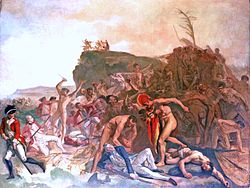 The Death of Captain James Cook, 14 February 1779, an unfinished painting by Johann Zoffany, circa 1795.[39]
The Death of Captain James Cook, 14 February 1779, an unfinished painting by Johann Zoffany, circa 1795.[39]
The esteem in which he was nevertheless held by the Hawaiians resulted in his body being retained by their chiefs and elders. Following the practice of the time, Cook's body underwent funerary rituals similar to those reserved for the chiefs and highest elders of the society. The body was disembowelled, baked to facilitate removal of the flesh, and the bones were carefully cleaned for preservation as religious icons in a fashion somewhat reminiscent of the treatment of European saints in the Middle Ages. Some of Cook's remains, disclosing some corroborating evidence to this effect, were eventually returned to the British for a formal burial at sea following an appeal by the crew.[40]
Clerke took over the expedition and made a final attempt to pass through the Bering Strait.[41] Following the death of Clerke, Resolution and Discovery returned home in October 1780 commanded by John Gore, a veteran of Cook's first voyage, and Captain James King.[42] Cook's account of his third and final voyage was completed upon their return by King.
David Samwell, who sailed with Cook on the Resolution, wrote of him:
He was a modest man, and rather bashful; of an agreeable lively conversation, sensible and intelligent. In temper he was somewhat hasty, but of a disposition the most friendly, benevolent and humane. His person was above six feet high: and, though a good looking man, he was plain both in dress and appearance. His face was full of expression: his nose extremely well shaped: his eyes which were small and of a brown cast, were quick and piercing; his eyebrows prominent, which gave his countenance altogether an air of austerity.[43]
Legacy
Cook's 12 years sailing around the Pacific Ocean contributed much to European knowledge of the area. Several islands such as Sandwich Islands (Hawaii) were encountered for the first time by Europeans, and his more accurate navigational charting of large areas of the Pacific was a major achievement.[44]
To create accurate maps, latitude and longitude need to be known. Navigators had been able to work out latitude accurately for centuries by measuring the angle of the sun or a star above the horizon with an instrument such as a backstaff or quadrant. Longitude was more difficult to measure accurately because it requires precise knowledge of the time difference between points on the surface of the earth. The Earth turns a full 360 degrees relative to the sun each day. Thus longitude corresponds to time: 15 degrees every hour, or 1 degree every 4 minutes.[45]
Cook gathered accurate longitude measurements during his first voyage due to his navigational skills, the help of astronomer Charles Green and by using the newly published Nautical Almanac tables, via the lunar distance method—measuring the angular distance from the moon to either the sun during daytime or one of eight bright stars during night-time to determine the time at the Royal Observatory, Greenwich, and comparing that to his local time determined via the altitude of the sun, moon, or stars. On his second voyage Cook used the K1 chronometer made by Larcum Kendall, which was the shape of a large pocket watch, 5 inches (13 cm) in diameter. It was a copy of the H4 clock made by John Harrison, which proved to be the first to keep accurate time at sea when used on the ship Deptford's journey to Jamaica, 1761–62.[46]
Cook succeeded in circumnavigating the world on his first voyage without losing a single man to scurvy, an unusual accomplishment at the time. He tested several preventive measures but the most important was frequent replenishment of fresh food.[47] It was for presenting a paper on this aspect of the voyage to the Royal Society that he was presented with the Copley Medal in 1776.[48][49] Ever the observer, Cook was the first European to have extensive contact with various people of the Pacific. He correctly concluded there was a relationship among all the people in the Pacific, despite their being separated by thousands of miles of ocean (see Malayo-Polynesian languages). Cook came up with the theory that Polynesians originated from Asia, which was later proved to be correct by scientist Bryan Sykes.[50] In New Zealand the coming of Cook is often used to signify the onset of colonisation.[3][5]
Cook was accompanied on his voyages by many scientists, whose observations and discoveries added to the importance of the voyages. Joseph Banks, a botanist, went on the first voyage along with fellow botanist Daniel Solander from Sweden. Between them they collected over 3,000 plant species.[51] Banks became one of the strongest promoters of the settlement of Australia by the British, based on his own personal observations.[52][53]
There were also several artists on the first voyage. Sydney Parkinson was involved in many of the drawings, completing 264 drawings before his death near the end of the voyage. They were of immense scientific value to British botanists.[3][54] Cook's second expedition included the artist William Hodges, who produced notable landscape paintings of Tahiti, Easter Island, and other locations.
A number of the junior officers who served under Cook went on to distinctive accomplishments of their own. William Bligh, Cook's sailing master, was given command of HMS Bounty in 1787 to sail to Tahiti and return with breadfruit. Bligh is most known for the mutiny of his crew which resulted in his being set adrift in 1789. He later became governor of New South Wales, where he was subject of another mutiny—the only successful armed takeover of an Australian colonial government.[55] George Vancouver, one of Cook's midshipmen, later led a voyage of exploration to the Pacific Coast of North America from 1791 to 1794.[56] In honour of his former commander, Vancouver's new ship was also christened Discovery. George Dixon sailed under Cook on his third expedition, and later commanded an expedition of his own.[57]
His contributions to knowledge were internationally recognised during his lifetime. In 1779, while the American colonies were at war with Britain in their war for independence, Benjamin Franklin wrote to captains of American warships at sea, recommending that if they came into contact with Cook's vessel, they were to:
...not consider her an enemy, nor suffer any plunder to be made of the effects contained in her, nor obstruct her immediate return to England by detaining her or sending her into any other part of Europe or to America; but that you treat the said Captain Cook and his people with all civility and kindness, . . . as common friends to mankind.[58]
Unknown to Franklin, Cook had met his death a month before this "passport" was written.
Debates
Cook's voyages took place in the midst of 18th century debates about the ennobling or corrupting influence of Western civilisation, yet examination of Cook's journals reveal that he was not much interested in the idea of the noble savage. When, in the 19th century, there was discussion of the motives of navigators and explorers, Joseph Conrad contrasted Cook's "scientific" motives with the "acquisitive" motives of earlier generations of explorers. Yet the costs for Cook's three voyages were borne by the British government within a framework of objectives that had to stand up to taxpayer scrutiny and Cook often claimed territories for the British crown.[59] In the 20th century, there are those who believe, with Moorehead, whose book The Fatal Impact (1966) that Western civilisation brought a depressing train of consequences, including venereal disease, alcohol and firearms.[60] Later in the century, Cook's achievements, and in particular, the circumstances surrounding his death have become the subject of scholarly debate. Gananath Obeyesekere in The Apotheosis Of Captain Cook : European Mythmaking In The Pacific, (1992),[34] and Marshall Sahlins in How "Natives" Think: About Captain Cook, for Example (1995) disagree about the interpretation of the Hawaiian response to Cook as documented in the journals of Cook and his crew.[35]
Memorials
A US coin, the 1928 Hawaiian Sesquicentennial half dollar bears an image of Cook. Minted during the celebration marking the 150th anniversary of his discovery of the islands, its low mintage (10,008) has made this example of Early United States commemorative coins both scarce and expensive.[61] The site where he was killed in Hawaii is marked by a white obelisk, built in 1874, and about 25 square feet (2.3 m2) of land around it is chained off. This land, though in Hawaii, has been given to the United Kingdom. Therefore, the site is officially a part of the UK.[62] A nearby town is named Captain Cook, Hawaii as well as several businesses. The Apollo 15 command module Endeavour was named after Cook's ship, HMS Endeavour,[63] as is the space shuttle Endeavour.[64] Another shuttle, Discovery, is named after Cook's HMS Discovery.[65]
The first tertiary education institution in North Queensland, Australia was named after him, with James Cook University opening in Townsville in 1970.[66] In Australian rhyming slang the expression "Captain Cook" means "look".[67] Numerous institutions, landmarks and place names reflect the importance of Cook's contribution to knowledge of geography. These include the Cook Islands, the Cook Strait, Cook Inlet, and the Cook crater on the Moon.[68] Aoraki/Mount Cook, the highest summit in New Zealand, is named for him.[69] Another Mount Cook is on the border between the US state of Alaska and the Canadian Yukon Territory, and is designated Boundary Peak 182 as one of the official Boundary Peaks of the Hay–Herbert Treaty.[70]
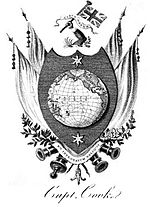 The coat of arms of James Cook granted by King George III to Cook's widow in 1785, to be borne by his descendants and 'placed on any monument or otherwise to his memory'[71]
The coat of arms of James Cook granted by King George III to Cook's widow in 1785, to be borne by his descendants and 'placed on any monument or otherwise to his memory'[71]
One of the earliest monuments to Cook in the United Kingdom is located at The Vache, where it was erected in 1780 by Admiral Hugh Palliser, a contemporary of Cook and one time owner of the estate.[72] A huge obelisk was built in 1827 as a monument to Cook on Easby Moor overlooking his boyhood village of Great Ayton.[73] In 1978, on the 250th anniversary of Cook's birth, at the site of his birthplace in Marton, the Captain Cook Birthplace Museum, which is located within Stewart Park, was opened. A granite vase just to the south of the museum marks the approximate spot where he was born.[74] Tributes also abound in post-industrial Middlesbrough, and include a primary school,[75] shopping square[76] and the Bottle 'O Notes a public artwork by Claes Oldenburg erected in the town's Central Gardens in 1993. Also named after Cook is the James Cook University Hospital, a major teaching hospital opened in 2003.[77]
The Royal Research Ship RRS James Cook was built in 2006 to replace the RRS Charles Darwin in the UK's Royal Research Fleet[78] and Stepney Historical Trust has placed a plaque on Free Trade Wharf in the Highway, Shadwell to commemorate his life in the East End of London.
See also
- Australian places named by James Cook
- European and American voyages of scientific exploration
- Exploration of the Pacific
References
Footnotes
- ^ Old style date: 27 October
- ^ At this time, the International Date Line had yet to be agreed, and so, the dates in Cook's journal are a day earlier than those accepted today.
Notes
- ^ a b c Rigby & van der Merwe 2002, p. 25
- ^ Stamp 1978, p. 1
- ^ a b c d e f g h i Collingridge 2003
- ^ Collingridge 2003, p. 15
- ^ a b c Horwitz 2003
- ^ a b Hough 1994, p. 11
- ^ a b c Rigby & van der Merwe 2002, p. 27
- ^ "Famous 18th century people in Barking and Dagenham". London Borough of Barking and Dagenham. http://www.lbbd.gov.uk/MuseumsAndHeritage/Documents/Infosheet22JamesCookDickTurpin.pdf.
- ^ Stamp 1978, p. 138
- ^ McLynn 2011, p. 21
- ^ a b c d e Williams, Glyn (17 February 2011). "Captain Cook: Explorer, Navigator and Pioneer". BBC. http://www.bbc.co.uk/history/british/empire_seapower/captaincook_01.shtml. Retrieved 5 September 2011.
- ^ Capper, Paul (1985–96). "The Captain Cook Society: Cook's Log". Life in the Royal Navy (1755–1767)]. http://www.captaincooksociety.com/ccsu62.htm. Retrieved 22 September 2011.
- ^ Kemp 2005
- ^ Hough 1994, p. 32
- ^ Rigby & van der Merwe 2002, p. 30
- ^ "1911 Encyclopædia Britannica/Cook, James - Wikisource". http://en.wikisource.org/wiki/1911_Encyclop%C3%A6dia_Britannica/Cook,_James. Retrieved 21 September 2011.
- ^ "Secret Instructions to Captain Cook, 30 June 1768". National Archives of Australia. http://www.foundingdocs.gov.au/resources/transcripts/nsw1_doc_1768.pdf. Retrieved 2011-09-03.
- ^ "Cook's Journal: Daily Entries, 22 April 1770". http://southseas.nla.gov.au/journals/cook/17700422.html. Retrieved 21 September 2011.
- ^ "Once were warriors - smh.com.au". http://www.smh.com.au/articles/2002/11/10/1036308574533.html. Retrieved 21 September 2011.
- ^ Robson 2004, p. 81
- ^ "Captain Cook: Obsession & Discovery. (Part 2 of 4) - Britain on DocuWatch - free streaming British history documentaries". 2011. http://britain.docuwat.ch/videos/empire-of-the-seas/captain-cook-obsession-discovery-part-2-of-4. Retrieved 5 September 2011.
- ^ Hough 1994, p. 180
- ^ McLynn 2011, p. 167
- ^ Hough 1994, p. 182
- ^ Hough 1994, p. 263
- ^ "Captain James Cook: His voyages of exploration and the men that accompanied him". National Maritime Museum. http://www.nmm.ac.uk/upload/package/30/links-cook.php. Retrieved 10 October 2007.
- ^ Beaglehole 1974, p. 444
- ^ Hough 1994, p. 268
- ^ Collingridge 2003, p. 327
- ^ Collingridge 2003, p. 380
- ^ Hayes 1999, pp. 42–43
- ^ "Resolution Cove". BC Geographical Names. http://apps.gov.bc.ca/pub/bcgnws/names/18990.html.
- ^ Fisher 1979
- ^ a b c d Obeyesekere 1992
- ^ a b Sahlins 1985
- ^ Obeyesekere 1997
- ^ Collingridge 2003, p. 410
- ^ Sheldon Dibble (1909). History of the Sandwich Islands. Honolulu: Thomas George Thrum. p. 61. http://books.google.com/?id=VPlfhWzRz_IC&pg=PR1.
- ^ "The Death of Captain James... (BHC0424) – National Maritime Museum". National Maritime Museum. http://www.nmm.ac.uk/collections/explore/object.cfm?ID=BHC0424. Retrieved 21 November 2010.
- ^ Collingridge 2003, p. 413
- ^ Collingridge 2003, p. 412
- ^ Collingridge 2003, p. 423
- ^ Samwell, David (1791). The death of Captain James Cook – Google Books. p. 20. http://books.google.co.uk/books?id=USMOAQAAIAAJ&pg=PA80&dq=Samwell++David.+He+was+a+modest#v=onepage&q&f=false. Retrieved 14 August 2011.
- ^ Cook, James (1784). A voyage to the Pacific Ocean ... - Google Books. http://books.google.com/books?id=O5AqNKtDqX0C&pg=PA222#v=onepage&q&f=false. Retrieved 26 August 2011.
- ^ "Celestial Sphere: The Apparent Motions of the Sun, Moon, Planets, and Stars - Earth, North, Axis, Approximately, Latitude, and Equator". 2011. http://science.jrank.org/pages/1304/Celestial-Sphere-Apparent-Motions-Sun-Moon-Planets-Stars.html. Retrieved 26 August 2011.
- ^ "Captain Cook – Cook's Chronometer – English and Media Literacy, Documentaries". dl.nfsa.gov.au. 2011. http://dl.nfsa.gov.au/module/1318/. Retrieved 8 August 2011.
- ^ Fernandez-Armesto 2006, p. 297
- ^ Stamp 1978, p. 105
- ^ Cook, Captain James (2011). "The Method Taken for Preserving the Health of the Crew of His Majesty's Ship the Resolution during Her Late Voyage Round the World". Philosophical Transactions. Royal Society Publications. http://rstl.royalsocietypublishing.org/content/66/402. Retrieved 10 August 2011.
- ^ Sykes 2001
- ^ "The Endeavour Botanical Illustrations at the Natural History Museum". nhm.ac.uk. 2011. http://www.nhm.ac.uk/jdsml/nature-online/endeavour-botanical/about2.dsml. Retrieved 8 August 2011.
- ^ "Sir Joseph Banks". BBC. 2011. http://www.bbc.co.uk/history/historic_figures/banks_sir_joseph.shtml. Retrieved 8 August 2011.
- ^ Gilbert, L. A.. Solander, Daniel (1733–1782). Australian Dictionary of Biography, National Centre of Biography, Australian National University. http://adb.anu.edu.au/biography/solander-daniel-2677. Retrieved 22 September 2011.
- ^ "The Endeavour Botanical Illustrations at the Natural History Museum". nhm.ac.uk. 2011. http://www.nhm.ac.uk/jdsml/nature-online/endeavour-botanical/people.dsml. Retrieved 8 August 2011.
- ^ "Biography: William Bligh | Online Information Bank | Research Collections | Royal Naval Museum at Portsmouth Historic Dockyard". royalnavalmuseum.org. 2011. http://www.royalnavalmuseum.org/info_sheets_william_bligh.htm. Retrieved 7 August 2011.
- ^ Phillips, Nan. Vancouver, George (1757–1798). Australian Dictionary of Biography, National Centre of Biography, Australian National University. http://adb.anu.edu.au/biography/vancouver-george-2755. Retrieved 22 September 2011.
- ^ "Dictionary of Canadian Biography Online". biographi.ca. http://www.biographi.ca/009004-119.01-e.php?&id_nbr=1855. Retrieved 7 August 2011.
- ^ Franklin, Benjamin (1837). The works of Benjamin Franklin. Tappan, Whittemore, and Mason. pp. 123–4. http://books.google.com/books?id=vVc-AAAAYAAJ&pg=PA124. Retrieved 22 September 2011.
- ^ "Background To Discovery". http://publishing.cdlib.org/ucpressebooks/view?docId=ft3489n8kn&chunk.id=d0e123&toc.depth=1&toc.id=d0e123&brand=ucpress. Retrieved 26 August 2011.
- ^ Moorhead 1966
- ^ "Hawaii Sesquicentennial Half Dollar". coinsite.com. 2011. http://www.coinsite.com/content/commemoratives/Hawaii.asp. Retrieved 8 August 2011.
- ^ "Captain Cook's Monument, Kealakekua Bay, Hawaii". Waymarking.com. http://www.waymarking.com/waymarks/WM54GK_Captain_Cooks_Monument_Kealakekua_Bay_Hawaii. Retrieved 22 September 2011.
- ^ "Call Signs". NASA. http://history.nasa.gov/SP-4029/Apollo_18-17_Call_Signs.htm. Retrieved 21 May 2011.
- ^ "Space Shuttle Endeavour". John F. Kennedy Space Center website. NASA. http://www-pao.ksc.nasa.gov/shuttle/resources/orbiters/Endeavour.html. Retrieved 21 May 2011.
- ^ "Space Shuttle Discovery". John F. Kennedy Space Center website. NASA. http://www-pao.ksc.nasa.gov/shuttle/resources/orbiters/Discovery.html. Retrieved 21 May 2011.
- ^ "Captain James Cook". James Cook University. 2011. http://www.jcu.edu.au/about/history/JCUPRD_048606.html. Retrieved 8 August 2011.
- ^ Sidney 1981, p. 160
- ^ "Planetary Names: Crater, craters: Cook on Moon". Gazetteer of Planetary Nomenclature. USGS/NASA. http://planetarynames.wr.usgs.gov/Feature/1292. Retrieved 21 September 2011.
- ^ "Aoraki Mount Cook National Park & Mt Cook Village, New Zealand". http://www.mtcooknz.com/mackenzie/Mount_Cook/. Retrieved 21 September 2011.
- ^ "Map of Mount Cook, Yukon, Mountain - Canada Geographical Names Maps". http://www.geodata.us/canada_names_maps/maps.php?featureid=KABJR&f=311. Retrieved 21 September 2011.
- ^ Wagner 1972
- ^ "CCS - Cook Monument at The Vache, Chalfont St. Giles - Access Restored". http://www.captaincooksociety.com/ccsu4166.htm. Retrieved 22 September 2011.
- ^ "Great Ayton - Captain Cook's Monument". http://www.great-ayton.org.uk/tourism/cook/cook_monument/. Retrieved 20 September 2011.
- ^ "The Captain Cook Birthplace Museum. Marton, Middlesbrough, UK". captcook-ne.co.uk. 2011. http://www.captcook-ne.co.uk/ccbm/index.htm. Retrieved 8 August 2011.
- ^ "Captain Cook Primary School". BBC. 2 December 2004. http://news.bbc.co.uk/1/shared/bsp/hi/education/04/school_tables/primary_schools/html/806_2370.stm. Retrieved 21 September 2011.
- ^ "Captain Cook Shopping Square". Captaincookshopping.com. http://www.captaincookshopping.com/. Retrieved 8 March 2010.
- ^ "Captain Cook and the Captain Cook Trail". http://www.glendalehouse.co.uk/pages/captainCook.html. Retrieved 22 September 2011.
- ^ "NERC – RRS James Cook". nerc.ac.uk. 2011. http://www.nerc.ac.uk/research/sites/facilities/marine/jamescook.asp. Retrieved 8 August 2011.
Bibliography
- Beaglehole, John Cawte (1974). The Life of Captain James Cook. A & C Black. ISBN 0713613823.
- Collingridge, Vanessa (February 2003). Captain Cook: The Life, Death and Legacy of History's Greatest Explorer. Ebury Press. ISBN 0091888980.
- Fernandez-Armesto, Felipe (2006). Pathfinders: A Global History of Exploration. W.W. Norton & Company. ISBN 0393062597.
- Fisher, Robin (1979). Captain James Cook and his times. Taylor & Francis. ISBN 9780709900504. http://books.google.com/books?id=dhsOAAAAQAAJ.
- Hayes, Derek (1999). Historical Atlas of the Pacific Northwest: Maps of exploration and Discovery. Sasquatch Books. ISBN 1-57061-215-3. http://books.google.com/?id=sl57oHrVXGoC.
- Horwitz, Tony (October 2003). Blue Latitudes: Boldly Going Where Captain Cook Has Gone Before. Bloomsbury. ISBN 0747564558.
- Hough, Richard (1994). Captain James Cook. Hodder and Stoughton. ISBN 0340825561.
- Kemp, Peter; I. C. B. Dear (2005). The Oxford Companion to Ships and the Sea. OUP. ISBN 9780198606161.
- McLynn, Frank (2011). Captain Cook: Master of the Seas. Yale University Press. ISBN 9780300114218.
- Moorhead, Alan (1966). Fatal Impact: An Account of the Invasion of the South Pacific, 1767-1840. H Hamilton. ISBN 0241907578.
- Obeyesekere, Gananath (1992). The Apotheosis of Captain Cook: European Mythmaking in the Pacific. Princeton University Press.. ISBN 0691057524.
- Obeyesekere, Gananath (1997). The Apotheosis of Captain Cook: European Mythmaking in the Pacific. Princeton University Press. ISBN 9780691057521. "With new preface and afterword replying to criticism from Sahlins."
- Rigby, Nigel; van der Merwe, Pieter (2002). Captain Cook in the Pacific. National Maritime Museum, London UK. ISBN 0948065435.
- Robson, John (2004). The Captain Cook Encyclopædia. Random House Australia. ISBN 0759310114.
- Sahlins, Marshall David (1985). Islands of history. University of Chicago Press. ISBN 9780226733580.
- Sahlins, Marshall David (1995). How "Natives" Think: About Captain Cook, for example. University of Chicago Press. ISBN 9780226733685.
- Sidney, John Baker (1981). The Australian Language: An Examination of the English Language and English Speech as Used in Australia, from Convict Days to the Present. Melbourne: Sun Books. ISBN 9780725103828.
- Stamp, Tom and Cordelia (1978). James Cook Maritime Scientist. Whitby: Caedmon of Whitby Press. ISBN 0905355040.
- Sykes, Bryan (2001). The Seven Daughters of Eve. Norton Publishing: New York City, NY and London, England. ISBN 0393020185.
- Wagner, A.R. (1972). Historic Heraldry of Britain. London: Phillimore & Co Ltd. ISBN 9780850330229.
Further reading
- Aughton, Peter (2002). Endeavour: The Story of Captain Cook's First Great Epic Voyage. London: Cassell & Co.. ISBN 9780304362363.
- Edwards, Philip, ed (2003). James Cook: The Journals. London: Penguin Books. ISBN 0140436472. "Prepared from the original manuscripts by J. C. Beaglehole 1955–67"
- Forster, Georg, ed (1986). A Voyage Round the World. Wiley-VCH. ISBN 9783050001807. "Published first 1777 as: A Voyage round the World in His Britannic Majesty's Sloop Resolution, Commanded by Capt. James Cook, during the Years, 1772, 3, 4, and 5"
- Kippis, Andrew (1904). The Life and Voyages of Captain James Cook. George Newnes, London & Charles Scribner's Sons, New York.
- Richardson, Brian. (2005) Longitude and Empire: How Captain Cook's Voyages Changed the World University of British Columbia Press. ISBN 0774811900.
- Sydney Daily Telegraph (1970) Captain Cook: His Artists — His Voyages The Sydney Daily Telegraph Portfolio of Original Works by Artists who sailed with Captain Cook. Australian Consolidated Press, Sydney.
- Thomas, Nicholas (2003) The Extraordinary Voyages of Captain James Cook. Walker & Co., New York. ISBN 0802714129
- Villiers, Alan (Summer 1956–57). "James Cook, Seaman". Quadrant 1 (1): 7–16.
- Villiers, Alan John, (1903) Captain James Cook Newport Beach, CA : Books on Tape, 1983.
- Williams, Glyndwr, ed (1997). Captain Cook's Voyages: 1768–1779. London: The Folio Society.
External links
Biographical dictionaries
- 'Cook, James (1728–1779)', Australian Dictionary of Biography, Volume 1, Melbourne University Press, 1966, pp 243–244
- Biography at the Dictionary of Canadian Biography Online
- James Cook biography from the Dictionary of New Zealand Biography
Journals
- The Endeavour journal (1) and The Endeavour journal (2), as kept by James Cook – digitised and held by the National Library of Australia
- The South Seas Project: maps and online editions of the Journals of James Cook's First Pacific Voyage. 1768–1771, Includes full text of journals kept by Cook, Joseph Banks and Sydney Parkinson, as well as the complete text of John Hawkesworth's 1773 Account of Cook's first voyage.
- Digitised copies of log books from James Cook's voyages at the British Atmospheric Data Centre
- Works by James Cook at Project Gutenberg
Collections and museums
- Cook's Pacific Encounters: Cook-Forster Collection online Images and descriptions of more than 300 artefacts collected during the three Pacific voyages of James Cook.
- Images and descriptions of items associated with James Cook at the Museum of New Zealand Te Papa Tongarewa
- Archival material relating to James Cook listed at the UK National Register of Archives
- James Cook Birthplace Museum
- Hand drawn maps of southeastern coast of Australia in the American Geographical Society Library
Copley Medallists John Canton (1751) · John Pringle (1752) · Benjamin Franklin (1753) · William Lewis (1754) · John Huxham (1755) · Charles Cavendish (1757) · John Dollond (1758) · John Smeaton (1759) · Benjamin Wilson (1760) · John Canton (1764) · William Brownrigg / Edward Delaval / Henry Cavendish (1766) · John Ellis (1767) · Peter Woulfe (1768) · William Hewson (1769) · William Hamilton (1770) · Matthew Raper (1771) · Joseph Priestley (1772) · John Walsh (1773) · Nevil Maskelyne (1775) · James Cook (1776) · John Mudge (1777) · Charles Hutton (1778) · Samuel Vince (1780) · William Herschel (1781) · Richard Kirwan (1782) · John Goodricke / Thomas Hutchins (1783) · Edward Waring (1784) · William Roy (1785) · John Hunter (1787) · Charles Blagden (1788) · William Morgan (1789) · James Rennell / Jean-André Deluc (1791) · Benjamin Thompson (1792) · Alessandro Volta (1794) · Jesse Ramsden (1795) · George Atwood (1796) · George Shuckburgh-Evelyn / Charles Hatchett (1798) · John Hellins (1799) · Edward Charles Howard (1800)
Complete roster: 1731–1750 · 1751–1800 · 1801–1850 · 1851–1900 · 1901–1950 · 1951–2000 · 2001–present
Categories:- 1728 births
- 1779 deaths
- Captain James Cook
- Royal Navy officers
- British military personnel of the French and Indian War
- Circumnavigators of the globe
- English explorers
- English sailors
- English cartographers
- English people of Scottish descent
- Explorers of Australia
- Explorers of British Columbia
- Explorers of the Pacific
- Fellows of the Royal Society
- People from North Yorkshire
- People from Middlesbrough
- Recipients of the Copley Medal
- 18th-century English people
- 18th-century explorers
- Explorers of Oregon
- People murdered in Hawaii
- Deaths by stabbing
- British people murdered abroad
- National Historic Persons of Canada
- Explorers of New Zealand
Wikimedia Foundation. 2010.


